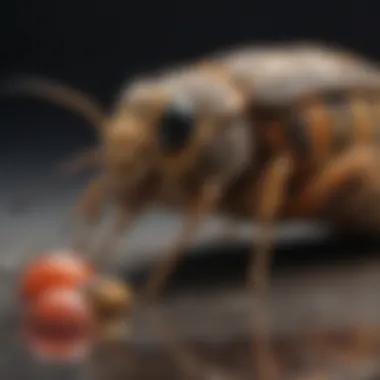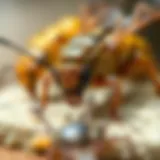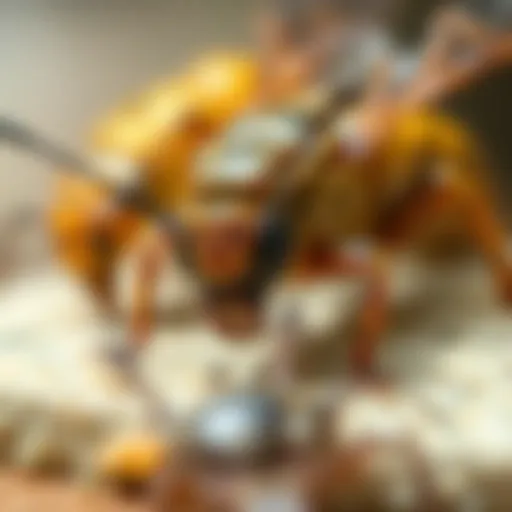Official Strategies for Effective Pest Prevention


Intro
Pest management is not just about exterminating bugs when they appear; it's a structured process that requires understanding and strategic action. This article aims to guide homeowners and pest control enthusiasts through pest prevention approaches recommended by authoritative organizations. With rising concerns about pest-related damages and health risks, being well-informed is crucial. Having a roadmap to combat pests before they become an issue is a worthy investment for your home.
Pest Identification
To effectively combat pests, the first step involves accurate identification. It’s like recognizing an old friend in a crowd—knowing the difference between what’s harmless and what’s harmful can mean the difference between a cozy home and a pest-invaded one.
Detailed Descriptions of Common Pests
A few pests that are commonly found in households include:
- Termites: Small, wood-eating insects that are notorious for causing severe structural damage.
- Ants: Tiny foragers that can invade kitchens and pantries in search of food.
- Cockroaches: Brown or black critters that prefer dark, humid spaces. They can carry various pathogens.
- Bed Bugs: These small, flat insects bite at night, causing itchy welts and discomfort.
Understanding these creatures helps in recognizing their potential threats to your living environment.
Signs and Symptoms of Infestations
Recognizing signs is paramount before the situation spirals out of control. Look for:
- Droppings: Tiny droppings may indicate active infestations.
- Damage: Hollowed wood or small holes in surfaces can be a sign of termites at work.
- Nests: Ants and roaches often create nests in hidden corners.
- Bites or Scratches: Experiencing bites while sleeping could point to bed bugs.
Detecting these signs early can save you from ugly surprises and costly repairs.
Prevention Strategies
When it comes to keeping pests at bay, the old adage 'an ounce of prevention is worth a pound of cure' holds a certain weight. Focusing on proactive strategies can significantly minimize the chances of infestations.
Home Maintenance Tips for Pest Prevention
Here are few practical tips to consider for maintaining your home against pests:
- Seal Cracks and Openings: Check windows, doors, and the foundation for any gaps; seal those with caulk or weather stripping.
- Proper Food Storage: Store food in airtight containers to deter foraging ants and roaches.
- Keep Things Tidy: Regular clean-ups reduce clutter that provides hiding places for pests.
- Check for Moisture: Leaky pipes and standing water are inviting pools for various bugs. Fix any leaks you find.
Implementing these small tips can work wonders in creating a pest-free zone.
Natural Deterrents and Barriers
If you're leaning towards eco-friendlier approaches, consider these natural barriers:
- Diatomaceous Earth: This powder can be sprinkled in infested areas. It dehydrates insects, effectively killing them.
- Essential Oils: Oils like peppermint or tea tree can repel pests. A spray bottle mixed with water and a few drops can work well.
- Physical Barriers: Installing screens on windows and doors helps keep flying insects at bay.
These solutions are not just effective but also align with healthier living practices.
Treatment Options
Despite the best prevention strategies, sometimes pests can be stubborn. Knowing your treatment options empowers you to act swiftly and correctly.
Overview of Chemical vs. Natural Treatments
Choosing between chemical and natural treatments can feel like a toss-up.
- Chemical Treatments: These usually offer quick results but may come with toxicity concerns. Always read labels and follow safety guidelines.
- Natural Treatments: Often safer and eco-friendly, they may take longer to yield results, but are gentler on your home and environment.
Ultimately, it boils down to personal preferences and the species of pests you're dealing with.
Step-by-Step Guides for DIY Treatments
Considering a DIY approach? Here’s a simple guide for a natural treatment:
- Identify the Infestation Area: Observe where you see signs of pests.
- Prepare a Solution: Mix equal parts of vinegar and water in a spray bottle. Vinegar is a powerful odor repellent.
- Apply it Graciously: Spray the solution where you see pests, especially around doors and windows.
- Monitor the Situation: Keep an eye on the area for any further signs of activity.
Following these steps not only empowers you to take control, but it may also save your wallet a few dollars.
Prologue to Official Pest Prevention
When considering pest control, it’s essential to understand the frameworks and strategies that govern effective pest prevention. Rather than taking a slapdash approach, official pest prevention strategies provide a structured pathway, built upon guidelines and methodologies established by reputable organizations. They advocate for pest management that is not just efficient but also safe for humans, pets, and the environment.
Understanding the importance of official pest prevention is akin to knowing the lay of the land before setting out on a road trip. Just as any well-planned journey requires a map, knowledge of pest prevention strategies equips homeowners with the tools to manage their environments effectively. It ensures that individuals have a grasp of the potential threats posed by pests and how to preempt them.
In recent years, as issues around pests have become more prominent, so too has the need for structured prevention strategies. Here are some specific elements to consider:
- Safety: Official guidelines prioritize the health of the community. Using best practices in pest management minimizes risks associated with chemical use.
- Effectiveness: Following laid-out strategies usually yields better results than casual or reactive methods. They also address the issue of resistance, which is a growing concern in modern pest management.
- Sustainability: Many official strategies advocate for sustainable methods that rely less on chemicals, thus fostering a healthier ecosystem.
These strategies also factor in various methodologies—ranging from Integrated Pest Management (IPM) to community engagement efforts—that can substantially bolster pest control initiatives. Such comprehensive approaches are necessary for homeowners who wish to maintain a pest-free environment without inadvertently compromising safety or environmental health.
"Pest prevention isn’t just about eradication; it’s about understanding the dance between humans and nature."
With these considerations in mind, the following sections will unpack historical contexts, delve into methods of identification, and elucidate the various principles that underpin effective pest management. Each angle explored reinforces the idea that tackling pest issues is indeed a multifaceted endeavor that deserves careful attention.
Historical Context of Pest Control
Understanding the historical context of pest control reveals the evolution of human efforts to manage pests over the centuries. It’s not merely about current methods, but about how past practices shaped today’s strategies. The science of pest management is built on centuries of trial and error, experience, and developing technologies.
Evolution of Pest Management Practices
From ancient civilizations, people discovered ways to combat pests that threatened crops and health. The early Egyptians utilized natural substances, like sulfur, to deter pests. Moving forward to ancient Rome, vinegar and ash were commonly used as pest repellents. These methods lay the groundwork for what would later become a more systematic approach to pest management.
Over time, as agriculture progressed, so did the strategies against harmful insects. By the 19th century, the advent of chemistry gave rise to the first synthetic pesticides. However, these were often indiscriminate, wiping out beneficial species alongside the pests. It was a double-edged sword – effective for short-term control but detrimental in the long run.
Fast forward to the late 20th century when Integrated Pest Management (IPM) gained traction. IPM combines biological, cultural, and chemical practices in a sustainable manner. This shift acknowledges that merely eliminating pests is not enough; maintaining ecosystem balance is critical for long-term pest control. By taking this more holistic approach, it not only targets problem pests but also conserves beneficial organisms, which are vital in a healthy environment.
Milestones in Pest Prevention Regulation


A significant component of pest management history is the establishment of regulations. During the late 20th century, growing awareness of environmental hazards from pesticides led to the creation of regulatory bodies aimed at overseeing pest control measures. For instance, the establishment of the Environmental Protection Agency (EPA) in the United States in 1970 brought forth stringent guidelines on pesticide use. This regulation was pivotal in ensuring safer practices and mitigating the impacts of harmful chemicals on both human health and the environment.
Not only did regulations serve to protect ecosystems, but they also advanced research into pest behavior and more efficient, less harmful control methods. Countries initiated guidelines that mandated pest control operators to obtain licenses and certifications, ensuring that practitioners adhered to best practices. Such frameworks fostered accountability and established standards of excellence in pest management practices.
"History acts as a guiding light to inform current pest control strategies, reminding us that the ongoing relationship between humans and pests continuously evolves."
This historical context underscores the importance of learning from both failures and successes. Understanding where we’ve been can inform where we are going. As pest management practices continue to evolve, the focus remains on developing methods that balance effectiveness with sustainability, ensuring a pest-free future without compromising ecological integrity.
Understanding Pests: Identification and Impact
Understanding pests is crucial in pest prevention strategies because it lays the foundation for effective management. Identifying specific pests helps in determining appropriate control methods, which can save homeowners time, money, and frustration. Knowledge of pest behavior and characteristics not only informs preventative measures but also ensures that responses are tailored to the specific threats faced.
Whether it's preventing structural damage or mitigating health risks, recognizing the impact of pests on daily life is vital. Beyond just irritation, infestations can lead to significant economic losses and health issues. Consequently, having a comprehensive knowledge base about common pests can empower homeowners and pest control professionals alike in maintaining a pest-free environment.
Common Pests and Their Characteristics
Termites
Termites are often referred to as the unseen destroyers because they can compromise the structural integrity of homes without any visible signs at first. Their ability to consume cellulose in wood makes them particularly hazardous to structures. An important aspect of termites to note is their social structure; they exist in colonies, which can number in the millions. This characteristic not only helps them thrive but also complicates efforts to eliminate them once they infest a location.
Their omnivorous appetite makes termites a popular focus in pest prevention discussions. If left unchecked, these pests can cause extensive property damage, potentially costing homeowners thousands of dollars in repairs. The cost-effectiveness of early detection and treatment of termites cannot be overstated, highlighting the importance of proper identification.
Ants
Ants are among the most common household pests and can range from subtle nuisances to major infestations. One of their distinguishing features is their ability to communicate and work together, creating efficient foraging trails. This characteristic allows them to exploit food sources rapidly, making them a formidable adversary in food contamination scenarios.
What sets ants apart in the context of pest management is their high adaptability. They can survive in varied environments, from kitchens to gardens, which increases the likelihood of encountering them in households. Despite being relatively easy to control compared to other pests, the challenge lies in their colonies. If their queen is not eliminated, infestations can persist, underscoring the need for thorough identification.
Rodents
Rodents, including mice and rats, pose significant threats not only through property damage but also through the diseases they carry. These creatures can gnaw through wires, insulation, and structural elements, leading to costly repairs and safety hazards. Their nocturnal nature often makes early detection difficult, allowing them to breed rapidly and lead to full-blown infestations.
One crucial aspect to highlight is their high reproductive rate. A pair of rodents can quickly multiply into dozens, indicating that swift identification and action are necessary. Moreover, their keen sense of smell and adaptability allows them to invade almost any space, making it all the more urgent for homeowners to be trained in recognizing signs of rodent presence.
Bed Bugs
Bed bugs have gained notoriety in recent years due to their resilience and ability to reproduce quickly. These pests are not just a bother; they can cause intense physical discomfort and anxiety due to their bites. A key characteristic of bed bugs is their ability to hide in the smallest cracks and crevices, making them challenging to eliminate.
For homeowners, understanding the unique habits of bed bugs—like feeding on human blood at night—highlights the need for preventive measures. Their presence signifies an infestation that not only threatens comfort but also can affect mental well-being, given the stigma associated with bed bug issues.
Economic and Health Implications of Pest Infestations
Pest infestations can have far-reaching economic and health implications for homeowners. Economically, damages caused by termites alone are estimated to reach billions annually. Issues with rodents and ants can result in not only the need for professional pest control services but also potential costs for repairs and treatment of contaminated food supplies.
Health-wise, pests such as rodents and bed bugs are vectors for diseases, posing risks to well-being and safety in living environments. From allergies and asthma triggered by pest droppings to potential outbreaks of diseases like hantavirus, understanding these implications positions homeowners to prioritize pest prevention and engage with effective management solutions.
"An ounce of prevention is worth a pound of cure"—being proactive about pest control can save not just damage costs but also health risks.
Principles of Effective Pest Management
Effective pest management is not merely a matter of eliminating visible pests; it encompasses a holistic method that includes prevention, monitoring, and control strategies. Understanding these principles is crucial for homeowners who aim to create a pest-free environment that is both healthy and sustainable. It promotes not only the well-being of individuals but also benefits the environment, which is a significant consideration in today’s eco-conscious world.
One of the key benefits of adhering to effective pest management principles is the reduction in reliance on harsh chemicals. Instead of resorting to toxic solutions at the first sight of trouble, homeowners can adopt practices that minimize risk and offer enduring solutions. For example, taking proactive measures, such as sealing potential entry points and maintaining cleanliness, often curbs infestations before they begin. This shift in mindset emphasizes the importance of prevention over reaction.
Integrated Pest Management (IPM) Approach
Integrated Pest Management, or IPM, is a multifaceted approach that merges various strategies to control pests while minimizing risks to people and the environment. At its core, IPM emphasizes the use of monitoring and data collection to inform decisions. Homeowners can keep track of pest activity through observation, setting traps, or utilizing pheromone monitors. The key here is to gather information about the pest’s lifecycle, behavior, and habitats in order to target control efforts effectively.
This strategy fosters flexibility; rather than sticking to one-size-fits-all solutions, homeowners can adapt their actions based on real-time insights. For instance, instead of applying pesticides indiscriminately, IPM encourages applying products only when specific pest populations reach action thresholds. Additionally, IPM promotes the use of biological controls, such as introducing beneficial insects that naturally suppress pest populations, reducing the need for chemical interventions.
A major strength of the IPM approach is its educational aspect. Homeowners are often unaware of the complex habits of pests and their environmental interactions. Through IPM, they gain valuable knowledge, empowering them to take charge of their pest issues. As a result, IPM is profoundly effective and cost-efficient, aligning with the goals of today’s conscientious homeowners seeking effective pest management without compromising safety.
Cultural and Mechanical Control Methods
Cultural and mechanical control methods serve as the backbone of an effective pest management strategy. Cultural controls involve altering practices to reduce pest establishment and survival. This could include practices like crop rotation in gardens or changing cleaning routines to avoid providing conducive conditions for pests to thrive.
For instance, maintaining a dry environment can be a simple yet effective way to deter pests such as ants or cockroaches from making themselves at home. Regularly cleaning gutters and ensuring no water stagnates can prevent water-loving pests from proliferating. Likewise, applying proper plant care techniques minimizes stress on plants, making them less vulnerable to infestations.
On the mechanical side, traps and barriers play pivotal roles. Installing door sweeps, using physical traps, or employing screens can create effective barriers against invading pests. These methods are particularly appealing to those reluctant to use chemical solutions. Mechanical approaches can be especially beneficial in more sensitive areas, such as kitchens or children’s playrooms.
By adopting cultural and mechanical strategies, homeowners not only enhance their pest prevention plans but also establish a more harmonious relationship with their environment. Overall, these principles strengthen the foundational practices of pest management, making it a sustainable and effective solution for household pest issues.
Government Regulations and Guidelines
In the ongoing battle against pests, government regulations and guidelines play a crucial role. They serve not just as a framework for pest management but also as a means to ensure public health and safety. Without these regulations, we might find ourselves in a situation where anyone can apply chemicals blindly, leading to adverse effects not only on pest populations but also on humans and the environment. Following these guidelines helps to minimize risks and ensures that pest control measures are effective.
National and Local Regulatory Frameworks
Regulatory frameworks, both at the national and local levels, set standards in pest management. National agencies like the Environmental Protection Agency (EPA) in the U.S. establish guidelines that address the safety of pesticides and their environmental impact. These regulations are designed to safeguard human health, protect beneficial organisms, and maintain ecological balance.
On the other hand, local regulations can adapt to the specific needs and pest concerns of a community. For instance, a city facing a significant rodent problem might have targeted initiatives that differ from regulations in a more rural area. It's important for homeowners and pest management professionals to be aware of these frameworks to avoid penalties and ensure that their pest control strategies align with legal requirements.
Licensing and Certification for Pest Control Professionals
Licensing and certification are not just bureaucratic hurdles; they are critical for maintaining high standards in pest control practices. Pest control professionals undergo rigorous training to ensure they understand both the techniques of pest management and the regulations that guide them.
- Benefits of Licensing:
- Ensures Expertise: Licensed professionals are well-equipped to handle various pest issues. They have the knowledge to apply the right methods safely and effectively.
- Protection for Consumers: Homeowners can have peace of mind knowing they are working with qualified individuals who follow established safety protocols.
- Responsible Use of Chemicals: Licensed operators are trained in the safe handling of pesticides, minimizing risks to the environment and public health.
“Licensing isn't just a piece of paper; it's assurance that someone knows what they're doing.”
In summary, the government regulations and guidelines represent a vital aspect of pest management strategies. Through national and local frameworks, along with licensing for pest control professionals, we see a structured approach that aims to protect both the community and the environment.
Community Engagement in Pest Prevention


Community engagement plays a vital role in effective pest prevention strategies. By involving local residents, stakeholders can create stronger connections to the issue at hand, raising awareness on pest issues and establishing a collaborative approach to minimize their impact. This involvement allows communities to foster a sense of ownership and responsibility over their environments. When everyone pitches in, the chances of pest infestations decrease significantly, creating healthier living spaces for all.
One of the key benefits of community engagement is the pooled knowledge it brings. People in the neighborhood often share insights about their experiences with pests, whether it's a specific problem they faced last summer or tips on prevention steps that worked well. Collectively, this information can lead to the development of customized strategies tailored to local issues. It’s not just about fighting pests; it’s about creating a community that supports sustainable living.
However, for community engagement efforts to truly flourish, several considerations should be taken into account. First, understanding your community's demographics is crucial. Tailoring educational content to meet the unique needs—be it families with children or the elderly—ensures better participation. Another important aspect is creating a platform that encourages ongoing dialogue. Whether through social media groups or local meetings, persistent communication allows for an exchange of ideas and strategies.
"When a community comes together, it possesses the power to change the landscape of its challenges."
Lee's Corner, a neighborhood in a bustling city, showcases how community engagement in pest prevention can work wonders. After an aggressive infestation of bed bugs highlighted their vulnerability, local residents organized community workshops. These sessions armed participants with knowledge about pest behaviors and prevention practices. Residents not only learned what to do but also shared their stories, emphasizing the collective spirit of problem-solving. This initiative not just reduced their pest problem significantly but also cultivated a supportive community atmosphere.
Educational Programs and Workshops
Educational programs and workshops serve as the backbone for community involvement in pest prevention. Properly designed educational activities can bridge the knowledge gap that often contributes to pest issues in homes. Residents, especially homeowners, gain from understanding pest habits, effective control measures, and how to spot potential infestations early on.
Running workshops isn't exclusively for experts; communities frequently invite local pest control professionals. These pros can provide direct insights and demonstrate best practices for prevention, offering practical, hands-on training. Furthermore, integrating local elements, such as emphasizing native pest species, enhances content relevance.
Role of Community Initiatives in Pest Control
Community initiatives are another powerful element in pest control efforts. Take, for instance, neighborhood clean-up days. These events not only beautify the local environment but also eliminate debris where pests may thrive. Similarly, community gardens, while promoting local food production, can adopt integrated pest management techniques that educate participants on natural pest control methods.
Online initiatives, like Facebook groups or community forums, can also extend the reach of these efforts. Residents can share their encounters with pests, share resources, or even alert neighbors about recent outbreaks. By utilizing digital platforms, communities can keep each other informed and proactive in addressing pest-related concerns.
Ultimately, community engagement in pest prevention is all about pulling together to foster a liveable, pest-free environment. From educating neighbors to collaborating on initiatives, there's no substitute for the power of community solidarity.
Innovative Technologies in Pest Prevention
In today’s world, where pest management is becoming increasingly intricate, innovative technologies in pest prevention have emerged as game-changers. These advancements not only enhance the effectiveness of pest control measures but also ensure better safety for humans and the environment. As pests develop resistance to chemical treatments, relying on novel approaches is critical for maintaining our homes and outdoor spaces pest-free.
Advancements in Pest Detection Tools
The initial step in addressing a pest problem is accurate identification, and this is where advancements in pest detection tools come into play. For instance, consider the use of smart traps equipped with sensors. These devices can monitor pest activity in real-time, sending alerts to homeowners’ smartphones. This means rather than waiting for sighting signs like droppings or damage, you can be proactive.
Another notable development is infrared imaging technology. It can detect changes in temperature associated with pest activity, especially for critters like termites that thrive within walls. Home inspectors armed with this technology can spot infestations hidden from plain sight. Moreover, in laboratories, researchers are developing electronic noses that can detect specific pheromones released by insects, pinpointing infestations more rapidly than traditional methods.
"The sooner you catch a pest problem, the less damage it can cause. Innovative detection tools make this possible at the touch of a button!"
Biological and Ecological Approaches
Moving beyond traditional chemical control, biological and ecological approaches recognize the significance of ecosystems in pest management. One prime example is the use of beneficial insects, like ladybugs, that feast on aphids, thus naturally curbing their populations. This method respects the balance of nature while controlling pest numbers effectively.
Furthermore, researchers are exploring the use of entomopathogenic fungi as natural pest controls. These fungi infect and kill certain insect pests while posing little threat to humans or beneficial species. Introducing such methods not only showcases innovation but also aligns with increasing consumer preference for environmentally friendly solutions.
In combination with the principles of Integrated Pest Management, these approaches can lead to more sustainable pest control practices. Homeowners can employ companion planting techniques, using certain plants to repel pests naturally. For instance, marigolds are known to deter nematodes and some beetles, making them an excellent addition to gardens.
To sum it up, leveraging these innovative technologies and ecological practices opens up a world of possibilities in pest prevention. They serve not just as panaceas but as integral parts of a thoughtful pest management strategy. The future of pest control lies in understanding and harmonizing with the ecosystems we inhabit.
Natural Pest Control Solutions
Natural pest control solutions stand out in the broader context of pest management by promoting methods that eschew synthetic chemicals in favor of environmentally friendly practices. This article delves into the importance of utilizing such solutions, particularly for eco-conscious homeowners. Implementing natural pest control can offer a wealth of benefits beyond mere pest eradication.
Firstly, natural methods tend to pose lower risks to human health and the environment. Many synthetic pesticides carry potential health hazards for families and pets, not to mention the adverse effects on local wildlife. By using natural alternatives, homeowners can maintain a safer living space while also supporting the ecosystem around them.
Beyond safety, many natural pest control methods encourage biodiversity. They often integrate aspects of sustainable gardening, promoting healthy soil and plant life. This can be particularly beneficial in urban areas where green spaces are at a premium. Furthermore, implementing natural solutions can empower homeowners, giving them a sense of agency over their pest management strategies while also fostering community knowledge sharing.
"Natural pest control aligns well with holistic gardening practices, proving that pest management can be both effective and ecologically sound."
Utilizing Essential Oils and Plant Extracts
Essential oils and plant extracts have been recognized for their pest-repelling properties, making them a popular choice for natural pest control. Oils such as peppermint, tea tree, and lavender hold potential as deterrents against various pests. When mixed with water and applied as sprays, these oils can keep unwanted visitors at bay without the dangerous repercussions harsher chemicals bring.
In addition to their pleasant scents, the active compounds in essential oils can disrupt the life cycles of pests. For instance, eucalyptus oil can hinder the reproductive capabilities of certain insects, resulting in fewer infestations long-term. However, it's important to note that while essential oils are effective against many types of pests, homeowners should conduct proper research to identify which oils are suitable for their specific challenges.
Here are a few common types of essential oils and their pest control benefits:
- Peppermint Oil: Effective against ants, spiders, and mice.
- Lavender Oil: A natural repellent for mosquitoes and moths.
- Tea Tree Oil: Known for its effectiveness against ants and some types of flies.
Companion Planting Techniques
Companion planting is another innovative natural pest control method that involves strategically placing plants together to enhance pest resistance. By understanding specific plant relationships, gardeners can utilize the natural chemistry between plants to deter pests or improve plant health.
For example, marigolds are well-known for their ability to repel nematodes and various insects, making them an ideal companion for vegetable gardens. Basil has been shown to fend off flies and mosquitoes while enhancing the growth of tomato plants. Such techniques not only mitigate pest issues but also provide additional culinary benefits for homeowners who appreciate fresh ingredients from their gardens.
Homeowners interested in companion planting should consider the following pairings:
- Tomato and Basil: Enhances flavor and helps repel pests.
- Carrots and Onions: Each deters pests that are attracted to the other.
- Cabbage and Dill: Dill attracts beneficial predators of caterpillars.
By implementing these natural approaches, homeowners can nurture their spaces while significantly reducing potential pest infestations, aligning pest control strategies with broader environmental goals.
Chemical Pest Control Methods
Chemical pest control methods are essential in the broader scope of pest management strategies. While many homeowners prefer natural solutions, chemicals remain a critical tool, especially when facing stubborn infestations. They serve not just as quick fixes but also have roles in integrated pest management systems. Understanding the nuances behind chemical use in pest control is crucial for effectively maintaining a healthy living environment.
Understanding Pesticide Types and Their Applications
Pesticides can be generally categorized based on their targeted pests and the mechanism of action. Here are some common types:
- Insecticides: Target insects directly. Products like pyrethroids are particularly popular for their broad effectiveness.
- Herbicides: Focus on controlling unwanted vegetation, which can harbor pests. Specific formulations tackle invasive plants while leaving desirable flora unharmed.
- Rodenticides: Designed specifically to combat rodent populations. Anticoagulant rodenticides are often used as they disrupt blood clotting in rodents, leading to mortality over several days.
Knowing these distinctions helps homeowners choose the right approach for their pest problems. For example, if one is dealing with both weeds and ants in their garden, understanding which pesticide to apply and where can enhance efficacy.
Safe Practices for Chemical Use
Safety is paramount when using chemicals for pest control. Here are several critical practices to bear in mind:
- Read Labels Thoroughly: Before use, take time to familiarize yourself with the label instructions. They provide necessary information on the dilution rates, application methods, and safety precautions.
- Wear Protective Gear: Using gloves, masks, and eye protection can help prevent exposure to harmful chemicals.
- Apply During Optimal Conditions: Avoid windy days and extreme temperatures when spraying chemicals. This helps prevent drift onto unintended areas, protecting valuable plants and wildlife.
- Store Chemicals Safely: Keep chemicals in their original containers, locked away, and out of reach of children and pets. An ounce of prevention here can prevent a lot of heartache.


"Applying pesticides without considering the environment can lead to resistance in pests and harm non-target species."
Following these guidelines not only secures your family’s health but also lends efficacy to pest control efforts. With the myriad of options available today, selecting safe, effective chemical solutions can protect your home with precision.
Case Studies on Successful Pest Management
The study of successful pest management case studies serves as a cornerstone for understanding effective pest prevention strategies. These narratives not only illustrate concrete applications of pest control principles but also highlight the practical outcomes of various methods. Through these examples, homeowners, pest control professionals, and community leaders can glean actionable insights that inform their approach to pest management. The importance of these case studies lies in their ability to serve as benchmarks, showcasing both the successes achieved and the challenges overcome in diverse environments.
Community-Based Success Stories
Community engagement proves vital in successful pest management strategies. When neighborhoods come together to address pest issues, the outcomes can be quite remarkable. For example, in a small town in southern Texas, residents faced a serious threat from termite infestations. Rather than allowing the problem to fester, the community banded together to educate one another on preventative measures.
They organized workshops to teach homeowners about termite signs and how to maintain their properties. Residents learned practical skills like inspecting wood structures and understanding the importance of moisture control. One resident recounted, "I never paid attention to my crawl space until my neighbor mentioned it. After a few simple fixes, I’ve noticed a drastic drop in termite activity."
This community-oriented effort not only provided immediate relief but also fostered a collective sense of responsibility and awareness regarding pest issues. The success story from Texas showcases the power of community-led initiatives, emphasizing that effective pest control is a shared responsibility.
- Key Elements of Success
- Collaborative workshops
- Sharing knowledge among residents
- Continuous monitoring and maintenance
Industry Innovations and Impact
In the realm of pest prevention, innovation often paves the way for more effective solutions. One remarkable case study involves a pest control company in California that integrated cutting-edge technology into their pest management protocols. By utilizing drone technology, they could inspect vast areas for pest activity without the time-consuming process of manual inspections.
The implementation of drone surveillance helped in identifying early signs of pest presence, which is essential for preventing larger infestations. Furthermore, this UAV (unmanned aerial vehicle) approach significantly reduced the use of pesticides, aligning with sustainable pest management practices.
Innovations like this point to a brighter future for pest management — one where technology enhances efficacy while minimizing environmental impact.
"Innovation is not just about coming up with new ideas but implementing them effectively for better outcomes."
As homeowners look to maintain their properties and safeguard their homes from pests, understanding such innovations can be a game-changer in making informed decisions regarding pest management.
- Impact of Industry Innovations
- Reduction of pesticide reliance
- Early detection through technology
- Improved efficiency in pest control processes
These case studies, whether emerging from grassroots community actions or high-tech industry advancements, underscore the importance of learning from practical experiences in pest management. In merging community effort and innovative technology, we glean valuable insights into how to combat pest issues effectively.
Challenges in Pest Prevention Today
The realm of pest prevention is not without its hurdles. Identifying and successfully managing pests can feel like hitting a moving target, particularly in the face of modern challenges. Understanding these issues is crucial for homeowners and pest control professionals alike, as it directly impacts the effectiveness of prevention methods and overall strategies. This section delves into two primary challenges—resistance to common pest control methods and the effects of climate change on pest behavior—highlighting their implications and the pressing need for adaptive approaches in pest management.
Resistance to Common Pest Control Methods
In recent years, pest resistance has emerged as a formidable obstacle for pest prevention efforts. This resistance often develops when pests are exposed to pesticides over time, leading to a scenario where the same chemicals that once effectively controlled pest populations are rendered ineffective. A classic example is the case of bed bugs. Once nearly eradicated, these pests are now making a notorious comeback, in part because they have adapted to resist many of the commonly used insecticides.
- Adaptation Mechanisms: Increasing frequency of pest adaptation to various control measures can leave homeowners feeling outmatched. These adaptations can include simply developing physiological changes that reduce the pesticide's effectiveness, creating a profound cycle of dependency on more potent chemicals.
- Economic Impact: The financial implications are significant. Pest control companies may need to develop new strategies or rely on more aggressive chemicals, leading to increased costs that are often passed on to consumers. Homeowners can find themselves spending a small fortune on pest treatments that might not even guarantee results.
Thus, this ongoing battle against resistance prompts a growing focus on utilizing integrated pest management strategies, which emphasize a multi-faceted approach to tackle pest populations at their source instead of merely treating symptoms.
Climate Change and Its Effects on Pest Behavior
Years of changing weather patterns cannot be ignored when discussing pest prevention strategies. Climate change drastically modifies ecosystems, triggering shifts in pest behavior, population dynamics, and geographical distributions. Pests that were once confined to specific regions are now showing up on doorsteps everywhere, due to warmer temperatures and changes in rainfall patterns.
- Expanded Habitats: The migration of pests into new territories shifts the burden of prevention. Homeowners in climates that were previously less susceptible to specific pests are now experiencing infestations of ants, termites, and even rodents that thrive in warmer settings. This calls for heightened vigilance and adaptation of current pest management practices.
- Life Cycle Alterations: Warmer temperatures can accelerate pest life cycles. A typical example involves mosquito populations, which can reproduce more rapidly when conditions become favorable, leading to increased instances of diseases spread by these pests.
"The future of pest prevention is as unpredictable as the climate; adaptability and guidance are key."
The intertwined nature of these challenges indicates that pest control will need to embrace innovative methodologies, focus on community engagement, and remain informed about global environmental shifts. As homeowners and professionals navigate this labyrinth, having a solid grasp on these challenges helps in devising suitable strategies to maintain pest-free living environments.
The Future of Pest Prevention
The realm of pest control is not stagnant; it's constantly evolving to meet new challenges and to integrate modern technology and practices. Understanding what lies ahead in pest prevention is crucial, especially for homeowners and community planners aiming to build resilient environments. The future doesn’t just focus on eliminating pests; it emphasizes sustainability, continuous adaptation, and community involvement, recognizing that pests can impact health, agriculture, and property values. With climate change altering ecosystems and pest behaviors, proactive measures are necessary to mitigate both immediate threats and long-term impacts on our surroundings.
Emerging Trends and Innovations in Pest Control
As we trot into this new era of pest prevention, several significant trends and innovations are reshaping the field:
- Biopesticides: Derived from natural materials, biopesticides offer a less toxic alternative to traditional chemicals. This trend leans towards environmental safety, appealing to eco-conscious homeowners while being effective against a myriad of pests.
- Smart Technologies: The integration of the Internet of Things (IoT) into pest control has laid the ground for smart traps and sensors that alert homeowners of infestations early on. Imagine a device that communicates directly with your smartphone, enabling quick and informed responses.
- Drones: Utilizing drones for surveillance can lead to better assessments of pest situations, especially in large areas such as farms or community gardens. They can provide real-time data that enhances the precision of pest management strategies.
- Genetic Control Methods: Innovative techniques like Sterile Insect Technique, which involves releasing sterile pests into the population, are emerging. This approach balances pest reduction while minimizing ecological disruption.
These innovations illustrate a shift not only in how to combat pests but also in how to approach pest management holistically, focusing on sustainability and safety.
The Role of Research and Development
Research and development (R&D) form the backbone of advancements in pest management. Here’s how:
- Understanding Pest Behavior: Through comprehensive studies, researchers develop insights into pest behavior, reproduction, and migration patterns. This information is critical for predicting outbreaks and implementing targeted control measures early on.
- Testing New Solutions: R&D enables the testing of novel pesticides and alternatives before they reach consumers. A rigorous evaluation process can prevent ineffective products from flooding the market, protecting homeowners from poor investments.
- Community Engagement: Researchers often collaborate with local communities to understand the specific challenges they face. This local knowledge can drive bespoke solutions that are more effective than generalized approaches.
- Adapting to Climate Change: Continuous research helps in adapting pest strategies to shifting climatic conditions. As certain species thrive in warmer temperatures, understanding these patterns allows for timely preventative actions.
Effective R&D not only addresses current pest challenges but also anticipates future complications, ensuring robust pest control frameworks.
As we look to the future, both emerging trends and the critical role of research will shape the landscape of pest prevention. Homeowners aren't just passive recipients of these changes; they are at the forefront of adopting these practices and technologies, paving the way for healthier living environments.
Final Considerations for Homeowners
As pests continue to be an ongoing concern for homeowners, understanding the nuances of pest prevention is crucial. Final considerations not only consolidate the knowledge shared throughout the article but also offer tangible benefits for maintaining a pest-free environment. It's about more than just reacting to a problem; it's about putting systems in place to prevent issues before they arise. These final elements can provide peace of mind, ensuring homes remain safe and healthy.
Implementing Continuous Monitoring and Assessment
To keep the pest problem at bay, there's no better strategy than continuous monitoring. Think of it like keeping an eye on a growing child; you can’t just check once a year! A proactive approach involves regularly inspecting the home for signs of pests. That means checking places that are dark and damp, like basements, kitchens, and even outside in the garden.
Benefits of Continuous Monitoring:
- Early Detection: Spotting issues before they snowball into significant infestations saves lots of hassle and money.
- Targeted Response: By identifying which pests are active, you can tailor your response — whether that��’s through traps or natural repellents.
- Sustainable Practices: If you can identify pests using less toxic methods proactively, it promotes a healthier home environment.
Actions to consider include the following:
- Routine Inspections: Make it a habit to inspect your home’s perimeter monthly.
- Pest Behavior Tracking: Keep a record of any pest sightings or signs. This will help spot trends, like seasonal activity.
- Engaging Professionals: Sometimes, a fresh set of eyes can make all the difference. It's not uncommon to call in a professional once in a while.
Building a Pest Prevention Plan
Having a solid plan means being ready for anything. A proactive pest prevention plan functions as an insurance policy against infestations. With a well-crafted strategy, homeowners can navigate potential pest-related troubles with greater ease. Here’s how to go about creating one:
- Assess the Environment: Identify areas in and around your home that could potentially attract pests. Think not only about access points but also water sources and food.
- Choose Methods: Decide on the methods that align best with your lifestyle and values, be it natural solutions, traps, or professional services. Having options at your fingertips will enhance your plan's effectiveness.
- Involve the Family: Engaging every member of the household ensures everyone is invested and aware. It also cultivates a culture of responsiveness — a little teamwork goes a long way.
- Plan for Changes: Life is unpredictable, so it’s wise to be adaptable. If you notice a pest problem changing, your plan should pivot accordingly, recalibrating as new challenges arise.
"Prevention is always better than a cure — it’s easier to keep pests out than to get them out once they’ve settled in."



